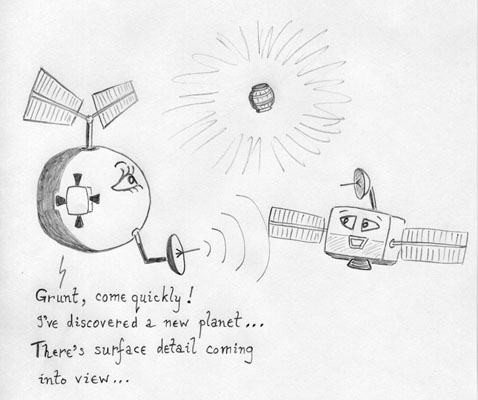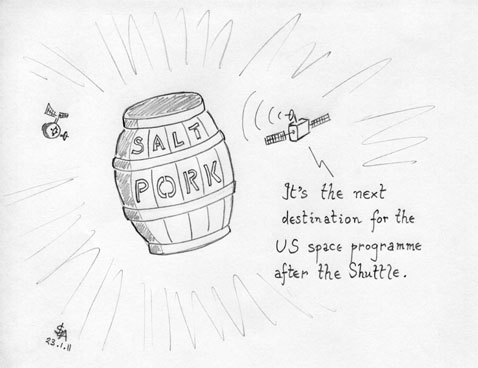===== ASTRONAUTICAL EVOLUTION =====
Issue 66, 1 February 2011 – 42nd Apollo Anniversary Year
- Social software for a spacefaring civilisation
- Best of the blogs
- Space cartoon of the month
All content is by Stephen Ashworth, Oxford, UK,
unless attributed to a different signed author.
=============== AE ===============
(1) Social software for a spacefaring civilisation
An ongoing exchange on the letters pages of Spaceflight raises the question of the moral values appropriate to a spacefaring society.
It’s all too easy to get carried away with hardware designs for vehicles and space bases, and worthwhile redressing the balance by considering the sort of social/ethical/political software needed in people’s hearts and minds to run such a society.
Historically, social values have generally been regarded as some kind of absolute external truth system, perhaps a bit like mathematics, which needs to be revealed to us from some divine repository of wisdom. I well remember once reading C. S. Lewis (probably in his book Mere Christianity) as he argued that no combination of physically observable circumstances could possibly convert a statement of what happens to a statement of what ought to happen. He was wrong, because his focus was too narrowly philosophical (not to say, theological).
In order to characterise the value system of the future one must divest it of this divine aura. Values are not divine commands, if only because no lawgiving anthropomorphic divine being is remotely in evidence, while those which may be unearthed in the stories contained in ancient literature are contradictory and parochial.
Rather, values should be seen as the biological equivalent of software. My computer runs Mac OS X. Modern developed society runs something like democratic humanism 1.1. The different versions of monotheism are dreadfully out of date (what guidance can they offer on nuclear weapons, genetic engineering, spaceflight and space colonisation, the evolution of Homo sapiens into successor species, the conflicts between different traditional religious systems? – and on what authority?).
Obviously it is historically correct to link Christian belief in the underlying order of the universe with the rise of science in the 17th and 18th centuries. But when a correspondent to Spaceflight (Feb. 2011, p.73) expresses fright over the abandonment of “an absolute source of morality”, he is only referring to one among a number of self-proclaimed absolutisms. The rejection of such traditional claims to absolute authority in moral matters has been one of the keys to the success of our civilisation since the Enlightenment. I suggest that the modern flexible, pluralistic, case by case attitude to resolving moral questions will continue to be essential in any civilisation (human or extraterrestrial) setting up space and planetary colonies.
On this subject I would strongly recommend Carl Sagan’s book The Demon-Haunted World (Headline, 1997). Sagan is passionate in his defence of a democratic, pluralist, critical, experience-based society. He is very clear that science is best served in a society in which religious belief (which he does not share) is a matter of individual conscience.
This is of course not to suggest that all moral questions boil down to mere differences of taste. There does indeed exist an absolute moral authority, just as there is an absolute authority for scientific truth and falsehood. That authority is in both cases the universe itself, approached through the critical, reasoning but fallible mind (human or alien). As Sagan says in his concluding chapter, every act of government is like a scientific experiment, and its consequences need to be studied and learned from as such.
Thus for example in the early 20th century is was not clear whether the future belonged to tolerant liberal democracy or to authoritarian tyranny. Thankfully it turned out that the more humanitarian forms of society were better able to compete in an environment of economic and technological progress than were the more repressive ones – a comparison made particularly clear by the contrasting American and Soviet experiences in the Moon race.
The ethical values which underlie society need to be understood as evolving under the twin pressures of social change on the one hand, which introduces mutations into existing ethical ideas, and practical external reality on the other, in which the consequences become apparent and societies which are more morally advanced tend to prosper at the expense of those which are less so. Some may regard this as the result of divine providence, and though I do not find this idea helpful I would nevertheless defend their right to do so.
In centuries to come humanity may face a number of desperately difficult moral dilemmas raised by further unprecedented developments in industrial pollution, machine intelligence, human genetic engineering, nanotechnology, extraterrestrial life, and the growth of new generations in space and planetary colonies beyond Earth. Our value system will be forced to evolve, and the only certainties we will find (and they will continue always to be provisional rather than absolute) will be those uncovered by our practical experience of grappling with those problems.
For more on this question, see my interview with Dr George Armstrong.
=============== AE ===============
(2) Best of the blogs
I’ve recently started visiting Centauri Dreams, which has a high quality of both postings and comments.
This page for an article about the Voyager probes, now over 116 AU from Earth and still returning useful data from the edge of the Solar System.
There is some ensuing discussion about whether or not we’re losing the will to explore, given that in the decades since the Voyagers were launched only one further probe has followed on a course for interstellar space (New Horizons). I think the conclusion has to be that gloom and doom is premature.
This page for discussion of the solar flare threat from red dwarfs.
Given that red dwarfs account for four out of every five stars in the Galaxy, and that they have the longest stellar lifetimes, their suitability as objects of colonisation by the Galaxy’s technological species (read that word as singular or plural as desired) will be a major factor affecting the long-term occupation of the Milky Way.
This page for Marc Millis’s report on the DARPA-NASA Ames 100-Year Starship Meeting – very interesting and informative.
The object of the meeting was to discuss, not a 100-year starship programme as the title suggests, but the foundation of a special organisation which would promote such a programme for 100 years. But do we really need another organisation devoted to promoting interstellar spaceflight – and thus duplicating what the Tau Zero Foundation, the British Interplanetary Society, Peregrinus Interstellar and other societies have already been doing for many years? And as Marc Millis points out, the BIS itself has already been active for the best part of a century (1933 to the present), proving that an official blessing from government agencies is not necessary to fulfil the brief.
=============== AE ===============
(3) Space cartoon of the month
Our space cartoon comes courtesy of Glob and Grunt, the two wandering space probes…

